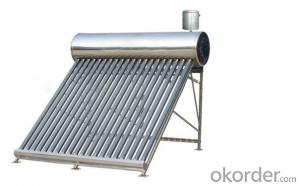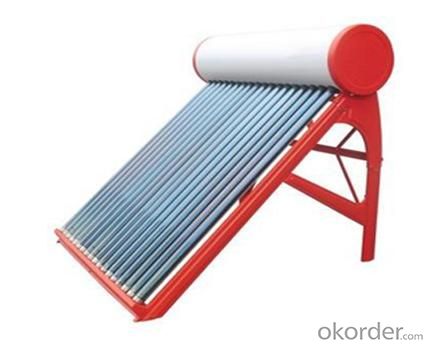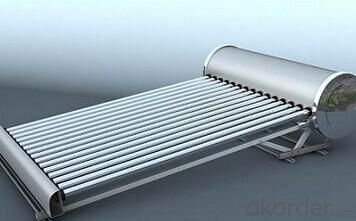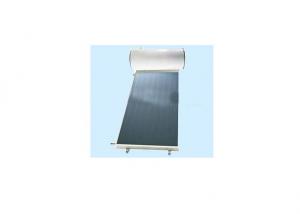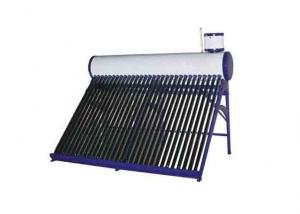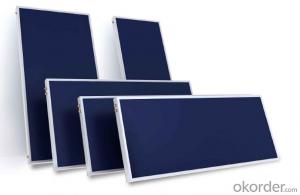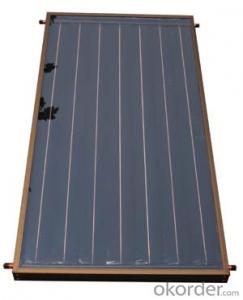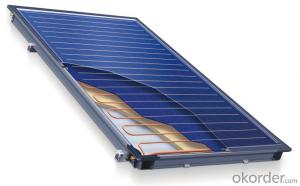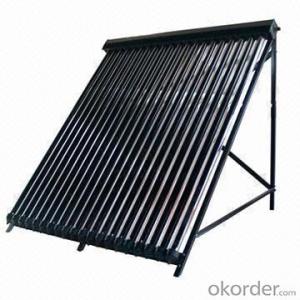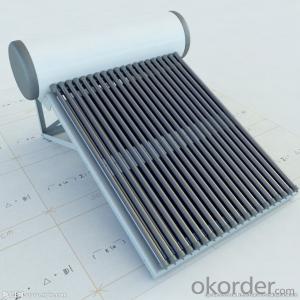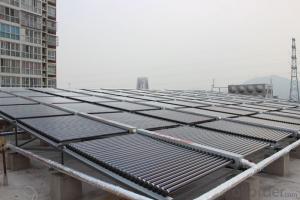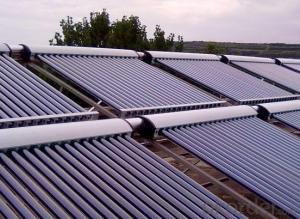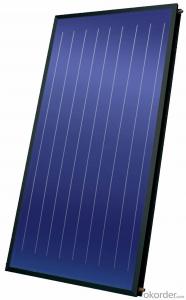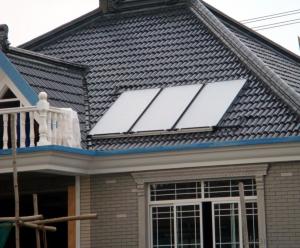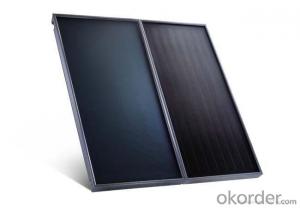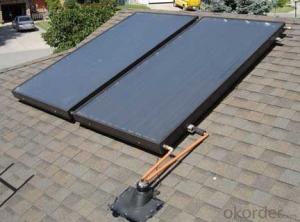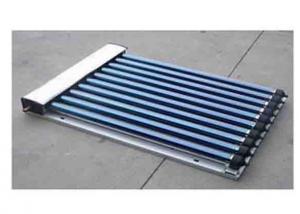Indoor Solar Collectors Non-Pressurized Heat Pipe Copper Solar Water Heater System
- Loading Port:
- China main port
- Payment Terms:
- TT OR LC
- Min Order Qty:
- 1 set
- Supply Capability:
- 6000 set/month
OKorder Service Pledge
OKorder Financial Service
You Might Also Like
Introduction of Non-Pressure Solar Water Heater:
Non-pressure Solar Heater is one of the most economical solar water heating device with pretty high efficiency at the same time. It consists of hot water storage tank, solar vacuum tubes with mouth plug in storage tank, and bracket supporting tank and tubes.When cold water in evacuated tubes is heated with solar irradiation, as the specific gravities of hot water and cold water are different, hotter water goes upward to storage tank and colder water goes downward to glass tubes. through this continuous circulation, the cold water in storage tank will be gradually heated till sunset.
Specialty:
1. High thermal performance and working temperature: the heat exchanging rate even in winter can up above 55%.
2. Heat collecting efficiency is at least 20% above common solar systems.
3. Work in all day and all season: no matter any corner of the world, this system can work well even -40℃ to avoid the tube freezing problem.
4. Reliability: No water following through the tube, so water scale can not generate and tube cracks could be avoided, the system still can keep working even with some damaged tubes.
5. It can connect with water tap and work automatically with pressure0.6Mpa, bring enjoyable washing experience.
6. Safety: P/T valve would release pressure and temperature to protect tank..
Technical Specification:
1. Outer tank material: SUS304 stainless steel or powder coated color steel
2. Inner tank material: 1.2mm thick SUS304 food grade stainless steel ( Optional material SUS316L)
3. Vacuum tube material: borosilicate glass 3.3; AL-SS-CU absorb coating, with copper heat pipe inside
4. Frame material: 1.2mm thickness stainless steel
5. Insulation material: 55mm thickness polyurethane
6. Suitable for mains pressure water(up to 8 bar/116psi)
7. Easy plug-in installation
8. Install the T/P valve on the pressurized tank
9. Seal material: Stabilized High Temperature Silicon
Outer tank material: SUS304 stainless steel or powder coated color steel
Inner tank material: 1.2mm thick SUS304 food grade stainless steel ( Optional material SUS316L)
Vacuum tube material: borosilicate glass 3.3; AL-SS-CU absorb coating, with copper heat pipe inside
Frame material: 1.2mm thickness stainless steel
Insulation material: 55mm thickness polyurethane
Suitable for mains pressure water(up to 8 bar/116psi)
Easy plug-in installation
Install the T/P valve on the pressurized tank
Seal material: Stabilized High Temperature Silicon
19. Vacuum Tube | 20. Size (mm) | 21. Φ47*1500 / Φ58*1800 / Φ70*2100 | |||||
22. Tube (pcs) | 23. 10 / 12 / 15 / 18 / 20 / 22 / 24 / 30 / 36 / 42 | ||||||
24. Material | 25. Borosilicate 3.3 glass, magnetron spluttering selective coating | ||||||
26. Coating | 27. Single-target AL-N/AL or Three-target AL/N-Cu-SS | ||||||
28. Water Tank | 29. Capacity | 30. 80L ~ 500L for hot water storage tank | |||||
31. Inner tank | 32. Food-grade stainless steel SUS304-2B / SUS316 | ||||||
33. Insulation | 34. High-density polyurethane foam with 70~80 hour heat preservation | ||||||
35. Tank shell | 36. Food-grade stainless steel SUS304-2B | ||||||
37. Bracket | 38. Shaped strong aluminum alloy structure adaptable for flat or slope roof | ||||||
39. Accessories | 40. Anti-aging silicon seals, Dustproof seals, Air-vent cap, Stainless screws | ||||||
41. Auxiliary Devices | 42. Assistant tank, Intelligent controller, Electrical heater, Magnesium anodes | ||||||
43. Tilt Angle | 44. 25 ~ 50° | ||||||
45. Water Output | 46. 45 - 95°C | ||||||
47. Hail Resistance | 48. Φ25mm diameter | ||||||
49. Model Number | 50. Solar Vacuum Tube | 51. Tank 52. Liter | 53. System 54. Liter | 55. Container Loading Qty /sets | |||
56. Size /mm | 57. Qty /pcs | 58. 20GP | 59. 40GP | 60. 40HQ | |||
61. VNS-58SA12-100 | 62. Φ58*1800 | 63. 12 | 64. 100 | 65. 132 | 66. 58 | 67. 119 | 68. 140 |
69. VNS-58SA15-130 | 70. 15 | 71. 130 | 72. 170 | 73. 54 | 74. 108 | 75. 131 | |
76. VNS-58SA18-150 | 77. 18 | 78. 150 | 79. 198 | 80. 43 | 81. 86 | 82. 105 | |
83. VNS-58SA20-170 | 84. 20 | 85. 170 | 86. 223 | 87. 40 | 88. 80 | 89. 97 | |
VNS-58SA24-200 | 24 | 200 | 263 | 35 | 70 | 85 | |
VNS-58SA30-250 | 30 | 250 | 329 | 28 | 56 | 68 | |
VNS-58SA36-300 | 36 | 300 | 395 | 23 | 47 | 57 | |
Product Show
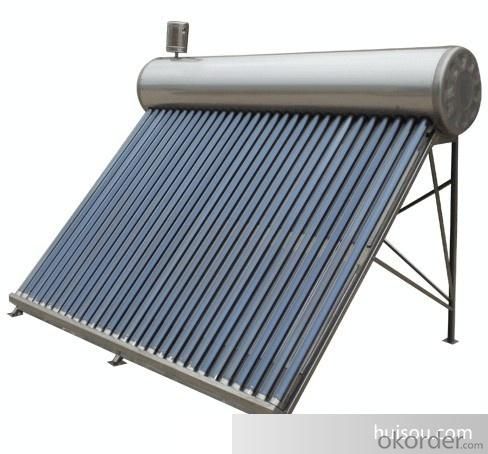
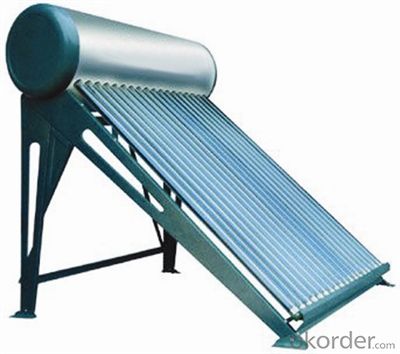
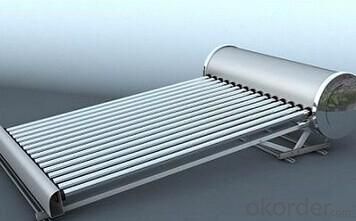
Our Services
1. OEM service
2. Warranty: 5 years
3. Considerable after sale service
Color steel Compact pressure Thermal solar heater
FAQ:
1. What’s the delivery time?
10 days after receiving deposit.
2. How long is the warranty?
5 years for whole system, 1 year for accessory
3. What’s your production capacity?
6000sets/month
4. What’s the MOQ?
1 set.
5. What’s your payment term?
Container: 30% T/T in advance for deposit, 70% T/T before shipment for fist order.
70% T/T after seeing copy of B/L from second order
Sample: 100% T/T in advance
Other choices: L/C at sight.
6. What certifications do you have?
CE, SOLAR KEYMARK, SRCC and etc.
- Q: Can solar collectors be used at night?
- No, solar collectors cannot be used at night as they rely on sunlight to generate electricity or heat.
- Q: How do solar collectors perform in coastal areas?
- Solar collectors perform well in coastal areas due to the abundance of sunshine and the cooling effect of the ocean breeze. The proximity to water allows for enhanced heat dissipation, which helps maintain optimal operating temperatures for the collectors. Additionally, the reflection of sunlight off the water surface can increase the overall efficiency of solar panels.
- Q: Are solar collectors reliable?
- Yes, solar collectors are reliable. They have proven to be efficient and durable over time, with minimal maintenance requirements. They harness the power of the sun to generate electricity or heat, providing a sustainable and renewable energy source. However, their reliability can be influenced by factors such as proper installation, quality of materials used, and regular maintenance.
- Q: Can solar collectors be used for electricity generation?
- Yes, solar collectors can be used for electricity generation. Solar collectors, such as photovoltaic (PV) panels, can convert sunlight directly into electricity through the photovoltaic effect. This process allows solar energy to be harnessed and used as a renewable source of electricity.
- Q: What is the environmental impact of solar collectors?
- Solar collectors have a positive environmental impact as they harness the sun's energy without emitting greenhouse gases or polluting the air, water, or soil. They contribute to reducing our reliance on fossil fuels and help combat climate change by producing clean and renewable energy. However, the manufacturing and disposal of solar collectors may have some environmental consequences, including the use of certain materials and energy during production. Overall, though, the environmental benefits of solar collectors significantly outweigh any potential drawbacks.
- Q: What is the effect of hail on solar collectors?
- The effect of hail on solar collectors can vary depending on the size and intensity of the hailstones. Small hailstones may not cause significant damage, but larger ones can potentially break or crack the glass surface of the solar collector, leading to reduced efficiency or complete failure of the system. Hail can also damage other components such as the frame, wiring, or mounting structure. Regular maintenance and protective measures like hail guards can help mitigate potential damage.
- Q: Can solar collectors be used in urban environments?
- Yes, solar collectors can be used in urban environments. With the advancements in solar technology, there are various types of solar collectors that can be adapted to fit urban settings. These collectors can be installed on rooftops, facades, or even integrated into building materials. Additionally, small-scale solar collectors can be used for individual households or businesses, allowing urban areas to benefit from renewable energy sources and reduce their carbon footprint.
- Q: Are solar collectors suitable for low-income households?
- Yes, solar collectors can be suitable for low-income households. They provide a cost-effective means of generating electricity or heating water, which can help reduce energy bills and alleviate financial burdens. Additionally, various government programs and incentives are available to support low-income households in adopting solar technology, making it an accessible and beneficial option for them.
- Q: Are solar collectors suitable for agricultural processing facilities?
- Yes, solar collectors are suitable for agricultural processing facilities. Solar collectors, such as solar panels or solar thermal systems, can provide a sustainable and cost-effective source of energy for these facilities. Agricultural processing facilities often require a significant amount of energy for activities such as drying crops, heating water, or powering machinery. By utilizing solar collectors, these facilities can reduce their dependence on traditional energy sources, lower their operational costs, and contribute to a greener and more sustainable agricultural sector. Solar collectors can be used to generate electricity through photovoltaic (PV) panels. This electricity can power various equipment and machinery in agricultural processing facilities, reducing the need for grid electricity or generators. Additionally, excess electricity generated by solar panels can be stored in batteries or fed back into the grid, providing an additional source of income for the facility. Solar thermal systems, on the other hand, can be used to harness the sun's heat for various applications in agricultural processing. This heat can be used for drying crops, heating water for cleaning or sterilization purposes, or even for space heating during colder months. Solar thermal systems can be integrated into existing systems, such as boilers or water heaters, to supplement or replace traditional energy sources like fossil fuels. Moreover, solar collectors offer several benefits beyond energy savings. They have a low maintenance requirement and a long lifespan, making them a reliable and durable option for agricultural processing facilities. Additionally, using solar energy can help reduce greenhouse gas emissions, contributing to a cleaner and healthier environment. Overall, solar collectors are a suitable and efficient solution for agricultural processing facilities, providing them with a sustainable and reliable source of energy, reducing operational costs, and supporting environmental conservation efforts.
- Q: Can solar collectors be used for heating cinemas?
- Yes, solar collectors can be used for heating cinemas. Solar thermal systems can capture the sun's energy and convert it into heat, which can be utilized for heating purposes in buildings. By installing solar collectors on the rooftop or nearby areas of a cinema, the collected solar energy can be used to heat the building, including the cinema halls. This can help reduce the reliance on traditional heating systems, decrease energy costs, and contribute to a cleaner and more sustainable energy source for heating cinemas.
Send your message to us
Indoor Solar Collectors Non-Pressurized Heat Pipe Copper Solar Water Heater System
- Loading Port:
- China main port
- Payment Terms:
- TT OR LC
- Min Order Qty:
- 1 set
- Supply Capability:
- 6000 set/month
OKorder Service Pledge
OKorder Financial Service
Similar products
Hot products
Hot Searches
Related keywords
